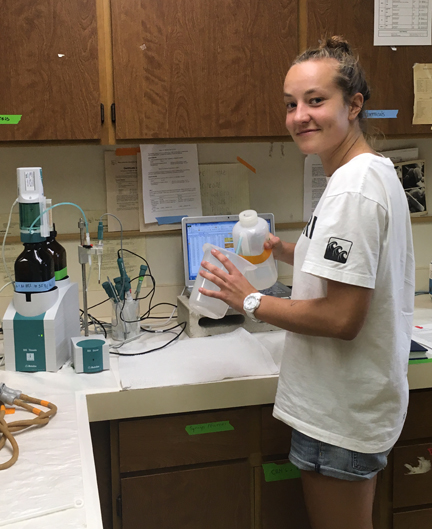Coastal Ocean Hawaiʻi Acidification Monitoring Network (COHAMN) and carbonate mineral dissolution study
PRINCIPAL INVESTIGATOR: Eric DeCarlo
Co-INVESTIGATORS: Michael Guidry, Fred Mackenzie
Graduate Fellow: Lucie Knor

Human emissions of carbon dioxide into the atmosphere have led to partial uptake of this gas by the oceans. This process increases the acidity of the oceans, has been dubbed Ocean Acidification (OA) and affects adversely the ability of organisms to make calcium carbonate shells and skeletons. How OA occurs is fairly well known; however, how organisms and especially coral reef structures (which are effectively fossils) respond to OA remains incompletely understood. Computer simulations suggest a future corrosive marine environment where dissolution of existing carbonate sediments will exceed production because corals will have difficulty growing at current rates. Early research on OA focused largely on the open-ocean and temperate coastal areas, and it is only more recently that tropical estuaries and coral reefs began to draw the attention of scientists. Because these areas represent a significant fraction of the global system, they play a critical role in the global carbon cycle. Our research was the first to show that (often extreme) variability in conditions over space and time is the rule rather than the exception in coastal coral reef environments, and for this reason, time series data in different reef settings in Hawaiʻi are critical to understand fully and quantify their contribution to carbon cycling. Furthermore, our work has yielded the longest continuous record of carbon dioxide concentrations in coral reef settings and in that regard is somewhat analogous to the work by Keeling who measured carbon dioxide concentrations in the atmosphere at Mauna Loa, and produced irrefutable evidence of how human activities have changed the composition of our atmosphere.
We now offer to continue our highly successful monitoring project of carbon dioxide cycling (newly dubbed Coastal Ocean Hawaiʻi Acidification Monitoring Network or COHAMN) and a more recent study of carbonate mineral stability in barrier and fringing reef settings. Our objectives will be achieved in part through the collection of high temporal frequency data at the four buoys of the COHAMN. The buoy locations differ in a variety of ways that will help us to constrain better how physical forces and biological processes interact to affect carbon system parameters and drive the production and dissolution of carbonate minerals. The latter aspect will be achieved by conducting a series of field and laboratory experiments that are designed based on our observations made at COHAMN sites. We will follow protocols used in our ongoing SeaGrant funded studies conducted in a close and successful collaboration with our colleagues at NOAA/PMEL. Our buoys are now part of a national coral reef monitoring program and the global OA observing network (GOA-ON) and are key sites for this work. We will quantify carbon system dynamics and carbon dioxide in different coral reef settings representative of a substantial portion of the subtropical coastal ocean, and will also determine the extent and rates of carbonate mineral dissolution in the water column and sediments of coral reef ecosystems. The lab experiments will supplement this work and provide a fundamental understanding of how these processes take place under in-situ conditions. For the past seven years, we have built upon the successful approach employed in earlier work to obtain high-frequency time-series records at multiple sites and have developed a sound understandings of how physical processes act in concert with biological activity and impact carbon dioxide concentrations in the ocean. We have shown coastal reefs of Oahu are net annual sources of carbon dioxide to the atmosphere, as opposed to the open ocean, which is largely a sink of carbon dioxide, but the strength of the signal is seasonal and evidence to date exists suggests that fringing reef sites are slowly changing to become additional sinks of this greenhouse gas. Our research has led to three MS theses and we have graduated one PhD during this time. Each of our graduates is now working in closely related technical fields, and three other students are now pursuing MS or PhD in our group. Multiple conference presentations have been made each year of this project’s lifetime and we have received invitations to participate in four workshops, several of which were key in establishing broadly based ocean observing programs. We have also published several monographs and book chapters based, in part, on the results of our research.
Watch a podcast on this project here.

